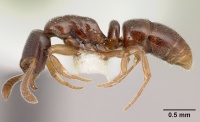Hypoponera segnis
| Hypoponera segnis | |
|---|---|

| |
| Scientific classification | |
| Kingdom: | Animalia |
| Phylum: | Arthropoda |
| Class: | Insecta |
| Order: | Hymenoptera |
| Family: | Formicidae |
| Subfamily: | Ponerinae |
| Tribe: | Ponerini |
| Genus: | Hypoponera |
| Species: | H. segnis |
| Binomial name | |
| Hypoponera segnis Bolton & Fisher, 2011 | |
Known only from a few collections, nothing is known about the biology of Hypoponera segnis.
Identification
Bolton and Fisher (2011) - Hypoponera segnis is very close to Hypoponera tristis, which is also from Rwanda and has the same type-locality. At present the two are separated only by the shape of the petiole, which is shorter in profile and distinctly broader in dorsal view in the former (compare indices). The differences in shape are consistent in the sparse material available.
A member of the abeillei group.
Keys including this Species
Distribution
Known from Democratic Republic of Congo, Kenya and Rwanda.
Latitudinal Distribution Pattern
Latitudinal Range: 0.6° to -2.050343°.
| North Temperate |
North Subtropical |
Tropical | South Subtropical |
South Temperate |
- Source: AntMaps
Distribution based on Regional Taxon Lists
Afrotropical Region: Democratic Republic of Congo, Kenya, Rwanda (type locality).
Distribution based on AntMaps
Distribution based on AntWeb specimens
Check data from AntWeb
Countries Occupied
| Number of countries occupied by this species based on AntWiki Regional Taxon Lists. In general, fewer countries occupied indicates a narrower range, while more countries indicates a more widespread species. |

|
Estimated Abundance
| Relative abundance based on number of AntMaps records per species (this species within the purple bar). Fewer records (to the left) indicates a less abundant/encountered species while more records (to the right) indicates more abundant/encountered species. |

|
Biology
Castes
Queens and males have not been collected.
Nomenclature
The following information is derived from Barry Bolton's Online Catalogue of the Ants of the World.
- segnis. Hypoponera segnis Bolton & Fisher, 2011: 99, figs. 109-111 (w.) RWANDA.
Unless otherwise noted the text for the remainder of this section is reported from the publication that includes the original description.
Hypoponera segnis is very close to Hypoponera tristis, which is also from Rwanda and has the same type-locality. At present the two are separated only by the shape of the petiole, which is shorter in profile and distinctly broader in dorsal view in the former (compare indices). The differences in shape are consistent in the sparse material available. The relationship of these two nominal species should be reassessed when more material is available. See also Hypoponera dema.
Description
Worker
(holotype in parentheses). Measurements: HL 0.65–0.77 (0.70), HW 0.50–0.60 (0.55), HS 0.605–0.680 (0.625), SL 0.46–0.58 (0.50), PrW 0.38–0.48 (0.44), WL 0.88–1.08 (0.95), HFL 0.47–0.60 (0.52), PeNL 0.17–0.20 (0.18), PeH 0.45–0.57 (0.47), PeNW 0.32–0.40 (0.35), PeS 0.320–0.380 (0.333) (20 measured). Indices: CI 76–81 (79), SI 86–98 (91), PeNI 77–86 (80), LPeI 32–43 (38), DPeI 180–220 (194).
Eyes absent or at most a single, poorly defined and very small ommatidium. Apex of scape, when laid straight back from its insertion, just fails to touch the midpoint of the posterior margin in full-face view; SL/HL 0.68–0.77. Pronotal dorsum almost smooth, obviously much less strongly and densely sculptured than the densely reticulate-punctate cephalic dorsum. Metanotal groove absent from dorsum of mesosoma or at most with a vestigial faint remnant. Propodeum marginate between declivity and side. Petiole in profile tall and slender, the node short from front to back and with a shallowly rounded dorsum. Posterior surface of petiole node without cuticular ridges that radiate upward from the peduncle. Subpetiolar process with an obtuse ventral angle. In dorsal view petiole node short and broad, with posterior face transverse and anterior face convex; node not thickly D-shaped. Maximum width of first gastral tergite in dorsal view slightly greater than width of second gastral tergite at its midlength. Cross-ribs at base of cinctus of second gastral tergite short but distinct. Midline length of second gastral posttergite, from posterior margin of cinctus to apex, slightly less than the width of the segment at its midlength. Disc of second gastral tergite with sharply incised small punctures that are separated by areas of glossy cuticle; the diameters of the punctures are equal to, or slightly less than, the distances that separate the punctures. First gastral tergite dorsally pubescent, without conspicuous standing setae that are clearly more erect and strongly project above the level of the pubescence; the few setae that are present are only fractionally longer than the pubescence and are indistinct.
Type Material
Holotype worker (top specimen of three on pin), Rwanda: Kayove, 2100 m., 23.iv.1973 (P. Werner) (Musee d'Histoire Naturelle Genève). Paratypes. 11 workers with same data as holotype; 12 workers with same data but 15.v.1973; 15 workers with same data but 12.viii.1973 (MHNG, The Natural History Museum, California Academy of Sciences).
References
- Bolton, B., Fisher, B.L. 2011. Taxonomy of Afrotropical and West Palaearctic ants of the ponerine genus Hypoponera Santschi. Zootaxa 2843: 1-118.
- Nsengimana, V., Hagenimana, T., Barakagwira, J., de Dieu Nsenganeza, J., Iradukunda, S. C., Majyambere, M., Kizungu, O. B., Nkundimana, A., Umutoni, D., Fabrice, R., Cyubahiro, B., Kouakou, L. M., Kolo, Y., Anale, J. S., Gómez, K., Dekoninck, W. 2023. Checklist of ant (Hymenoptera: Formicidae) species from Nyungwe Tropical Rain Forest, south-western Rwanda. Journal of East African Natural History 111(2), 69-81 (doi:10.2982/028.111.0203).
References based on Global Ant Biodiversity Informatics
- Bolton B. and B. L. Fisher. 2011. Taxonomy of Afrotropical and West Palaearctic ants of the ponerine genus Hypoponera Santschi (Hymenoptera: Formicidae). Zootaxa 2843: 1-118
- Bolton, B., and B. L. Fisher. "Taxonomy of Afrotropical and West Palaearctic ants of the ponerine genus Hypoponera Santschi (Hymenoptera: Formicidae)." Zootaxa 2843 (2012): 1-118.
- Garcia F.H., Wiesel E. and Fischer G. 2013.The Ants of Kenya (Hymenoptera: Formicidae)Faunal Overview, First Species Checklist, Bibliography, Accounts for All Genera, and Discussion on Taxonomy and Zoogeography. Journal of East African Natural History, 101(2): 127-222


